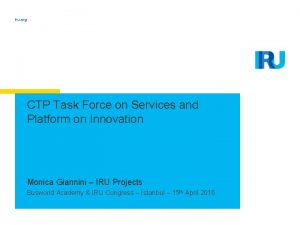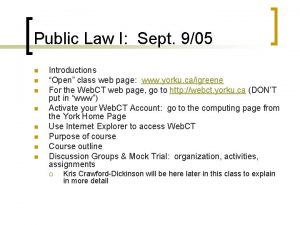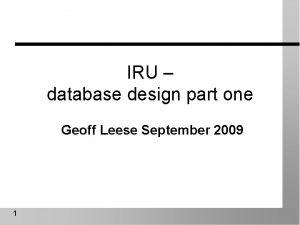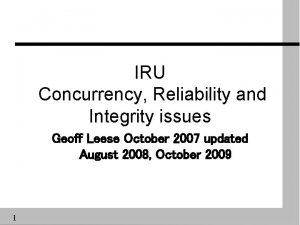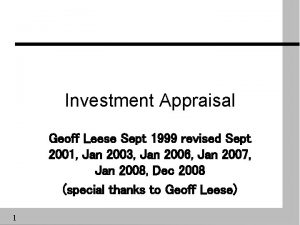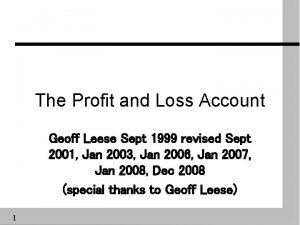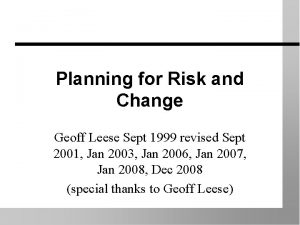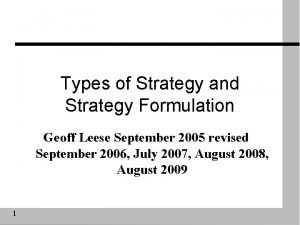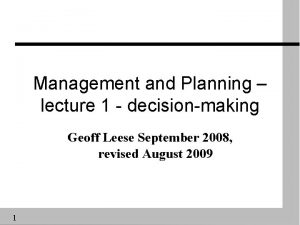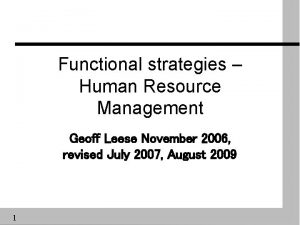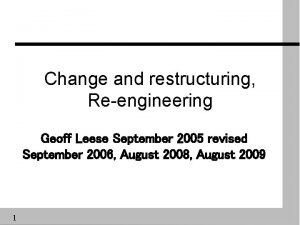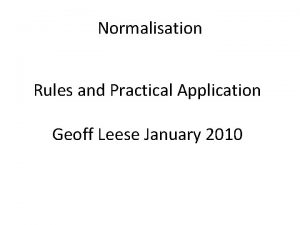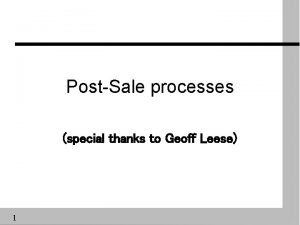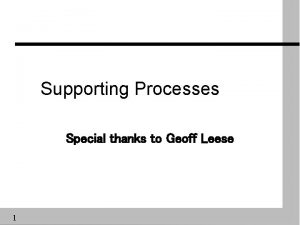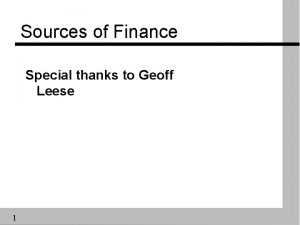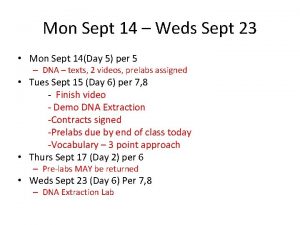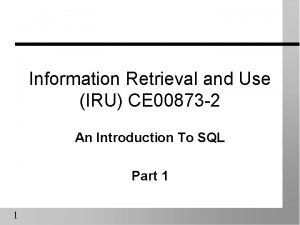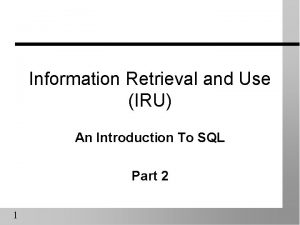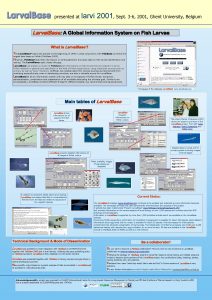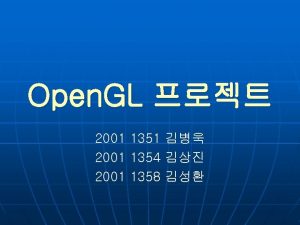IRU Data versus information Geoff Leese Sept 2001
























- Slides: 24

IRU Data versus information Geoff Leese Sept 2001, revised Sept 2002, Sept 2003, August 2008, October 2009 1

Objectives n n n Understand importance of information to management Distinguish between data and information Know how data are transformed into information Understand how information creates value Define the characteristics of good information Begin to understand the problems of perception 2

Importance of information Coping with change, complexity and uncertainty n Operations rarely observed directly n Information obtained by n ä Formal means ä Informal means 3

The value of information 4

Information - functions Reduction of uncertainty n Aid to monitoring and control n Means of communication n Memory supplement n Aid to simplification n 5

Categories of information Strategic-long-term planning, imprecise, largely external. “Soft”. n Tactical-medium-term e. g. departmental sales forecasts n Operational-short-term, immediate goals, largely internal, precise. “Hard” n 6

Levels of information International information, n National information, n Corporate information, n Departmental information, n Individual information, n 7

Relevant information Increases knowledge n Reduces uncertainty n Is usable for intended purpose n Depends on many things n ä Level of management, task in hand, urgency, confidentiality etc. . 8

Data and information defined Facts, events, transactions etc which have been recorded. They are the input raw materials from which information is produced. n Data that have been processed in such a way as to be useful to the recipient. n 9

Information classification n n n n By Source - internal, external etc. By Nature - quantitative, qualitative etc. By Level - strategic, tactical, operational By Time - historical, present, future By Frequency - continuous, hourly, daily etc. By Use - planning, control, decision making. By Form - written, aural, visual etc. By Occurrence - planned intervals, on demand. By Type - detailed, summarised, aggregated. 10

Characteristics of “good” information n n n n 11 relevant to purpose ä Up to date? ä “Unique”? ä Consistent? accurate enough for purpose ä How do we measure this? complete enough for purpose ä Is that ever possible? user has confidence in source communicated to right person in time for purpose contains right level of detail appropriate channel of communication used understandable by user

Perception and Language People see what they want to see! n Language simplifies things n What does “profit” mean? n Technical terms! n 12

Problems with numeric data Missing key data - not collected n Poor/incomplete measurement techniques n Subjective errors n Inappropriate methods n Poor presentation of results n Inaccuracy and misconceptions n 13

At the design stage n Uniqueness ä n Consistency ä ä n Foreign keys and referential integrity? Check constraints Triggers Dealing with unusual values Completeness ä ä 14 Primary keys? Dealing with null values Default values – use most common?

Management reports Reports provide information for decision-making n based on data n underlying data stored in a database n extracted by software e. g. Reports n 15

Types of management report Analyses n Forecasts n Optimisations n Regular cyclical reports e. g. payroll n Exception reports n Decision support n 16

Analyses Summary e. g. sales figures last year n Should offer typical default reports n Should allow custom reports for specific data requirements n The higher the level, the less detailed and the more summarised the information n 17

Forecasts & Predictions n n n 18 Predictions take historical data and project the future on their basis, e. g. time series predictions Forecasts based on subjective, conjectural data rather than historical data The further into the future the forecast or prediction, the less reliable it is Important not to get blinded by sophisticated mathematical techniques Need to consider the assumptions made

Optimisation reports Concerned with choosing the ‘best’ mix n Need to consider what is meant by ‘best’ n Optimising one factor is usually at the expense of other factors, e. g. time versus cost n 19

Examples of optimisation techniques n n n n 20 Linear programming Inventory modelling Resource allocation techniques Queuing theory Simulation Decision theory e. g. Goal Seek in Excel

Exception Reporting ‘No news is good news’ principle n ‘management by exception’ n how to decide what is exceptional? n parameters have to be continually reviewed n 21

Decision support systems Goal is to provide information to help decision-making n Best where there a number of possible alternative actions n may include automated OR or statistical techniques n often built on database queries or expert-systems n 22

Possible data storage locations local database e. g. Access on desktop PC n LAN database n company-wide database n Intranet-closed n Internet-open n 23

Reading Kendall and Kendall (Systems Analysis and Design 5 th Edition) chapters 19 and 20 n Date chapter 19 (heavy stuff!) n An opinion on Data Quality – click to follow the link n 24
 Mark leese
Mark leese Steve leese
Steve leese Tirepd.iru.org
Tirepd.iru.org Iru academy
Iru academy Damian viccars
Damian viccars Transpark iru
Transpark iru Iru malaga
Iru malaga Iru org
Iru org Intercity
Intercity Egm status
Egm status Data on the inside vs data on the outside
Data on the inside vs data on the outside Zero un deux trois quatre cinq six sept huit neuf
Zero un deux trois quatre cinq six sept huit neuf Deportes
Deportes La guerre de sept ans
La guerre de sept ans 7 hills of jerusalem
7 hills of jerusalem Poésie le blaireau sans gêne
Poésie le blaireau sans gêne Ecrivez les sept jours de la semaine
Ecrivez les sept jours de la semaine Sept commandements
Sept commandements Cnn 10 september 27 2021
Cnn 10 september 27 2021 Sept heure moins le quart
Sept heure moins le quart Accu poole sept
Accu poole sept Suture to stabilize suffix
Suture to stabilize suffix Sept
Sept I sept
I sept Sept comme setteur questionnaire
Sept comme setteur questionnaire







